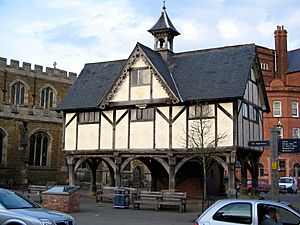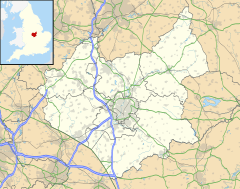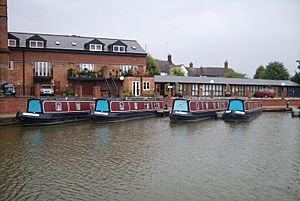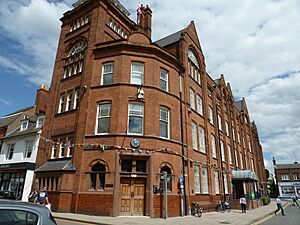Market Harborough facts for kids
Quick facts for kids Market Harborough |
|
|---|---|
| Town | |
 The Old Grammar School |
|
| Population | 24,779 (2021 census) |
| OS grid reference | SP7387 |
| • London | 88 miles (141.6 km) |
| District |
|
| Shire county | |
| Region | |
| Country | England |
| Sovereign state | United Kingdom |
| Post town | Market Harborough |
| Postcode district | LE16 |
| Dialling code | 01858 |
| Police | Leicestershire |
| Fire | Leicestershire |
| Ambulance | East Midlands |
| EU Parliament | East Midlands |
| UK Parliament |
|

Market Harborough is a lively market town in Leicestershire, England. It's located very close to the border with Northamptonshire. In 2021, about 24,779 people lived here. The town is also the main office for the Harborough district.
Long ago, Market Harborough was part of Rockingham Forest. This was a special hunting forest for kings and queens in the Middle Ages. The town is a key meeting point for roads and railways. The A6 and A14 roads now go around the town. Market Harborough railway station offers train services to cities like Leicester, Nottingham, Derby, Sheffield, and London St Pancras.
The unique steeple of St Dionysius' Church rises right from the street. This is because it doesn't have a churchyard. The church was built around 1470, and its steeple was added in 1300. Right next to the church is the Old Grammar School. This small timber building dates back to 1614. Its ground floor is open, which used to be a covered market. The single room upstairs was the school. This building is now a symbol of the town. The nearby town square is mostly for walking. It is surrounded by buildings of many different styles. The top part of the High Street has many beautiful old Georgian buildings.
Market Harborough also includes two villages: Great Bowden and Little Bowden. Great Bowden is about a mile away over a hill. Little Bowden is closer, less than half a mile from the town centre. Over time, these areas have grown together. However, Great Bowden still feels like a separate village.
Contents
- History of Market Harborough
- Geography of Market Harborough
- How Market Harborough is Governed
- Famous Landmarks in Market Harborough
- Places Near Market Harborough
- Economy of Market Harborough
- Culture and Fun in Market Harborough
- Sports and Leisure
- Transport in Market Harborough
- Media in Market Harborough
- Images for kids
- See also
History of Market Harborough
Early Days: Before 1066
Market Harborough was first settled by the Saxons. This was between the years 410 and 1066. It started as a small village. People believe its original name was Hæfera-beorg, which means "oat hill."
From 1066 to 1799
In 1086, the Domesday Book recorded Bowden as a Royal Manor. This meant it was owned by the King. The people lived in three villages: Great Bowden, Arden, and Little Bowden. The area of Harborough was first mentioned in 1199. It was likely created to be a market town. This happened when a new main road was built between Oxendon and Kibworth. This road helped connect Northampton and Leicester. A small church, called a chapel, was built for St Dionysius along this road.
A market was officially started by 1204. It has been held every Tuesday since 1221. This market is why the town is now called Market Harborough. The tradespeople in Harborough had large yards behind their shops. They used these yards to make and store goods. Many of these yards are still there today.
The steeple of Harborough Church was built between 1300 and 1320. By 1382, the village of Arden was no longer lived in. The main part of Harborough Church was finished in 1470. A stream used to run openly down the High Street. The Town Estate was set up to manage the town's lands. Money from these lands was used for many town needs.
Market Harborough was important during the English Civil War in June 1645. The King's army made its headquarters here. The King decided to fight the Parliament's army near Naseby. However, the Battle of Naseby was a big win for Parliament. Oliver Cromwell led Parliament's forces. Harborough Chapel was used as a temporary prison for captured soldiers. Cromwell even wrote a letter from "Haverbrowe" on June 14, 1645, to announce his victory.
In the 18th century, many old timber and thatch buildings were replaced with brick ones. Roads were improved, making travel easier. Market Harborough became a stop for coaches traveling to London. In 1776, the open fields around Great Bowden were divided and fenced. The same happened for Little Bowden in 1780.
From 1800 to 1899
In the 19th century, there was a lot of heavy traffic on the roads. So, a canal was planned. A branch canal was built from Foxton to Harborough. This created wharves (docking areas) for boats. Harborough wharf became a place to distribute coal and corn. A gas company started in 1833. Factories also began to open. These included a company making worsted fabric and carpets. Other businesses were a brickworks, a brewery, and a wheelwright shop.
In the 1830s, a group of parishes around Market Harborough formed a union. They built a workhouse in 1836 to help the poor. In 1841, Thomas Cook, a local cabinet maker, organized the first group train trip. This trip went from Leicester to Loughborough. He later founded the famous travel agency, Thomas Cook.
Market Harborough became a centre for fox hunting in the 19th century. A hunt was started in 1856. The area was known for its difficult "ox fences" to jump. The Grand National Hunt Steeple Chase was held near the town in 1860, 1861, and 1863. This race later became part of the Cheltenham Festival.
The building of the Leicester–Rugby railway in 1840 greatly reduced coach travel through the town. Market Harborough got its own railway links later. It connected to Rugby in 1850, and to Leicester and London in 1857. A link to Northampton followed in 1859.
In 1850, William Symington started a factory to make pea-flour. His brother, James, had a business making sewing items and corsets. In 1876, James's sons bought the old carpet factory to make corsets. They expanded it and built a new factory in 1884. This building is now the Council offices, library, and museum. Other factories, like the Harborough Rubber Company, also started.
The town's population grew quickly from 4,400 in 1861 to 7,700 in 1901. This growth led to crowded living conditions. New rules were made in 1875 to improve housing. Each house had to have its own sanitation and water. In 1883, a new sewer system was built. Piped water came from wells at Husbands Bosworth. New housing areas were also built.
From 1900 to 1999
In 1888, Little Bowden parish moved from Northamptonshire to Leicestershire. In 1894, an Urban District Council was formed for Market Harborough. This council worked to improve the town. It bought the gas company and built public baths. It also bought land to build Abbey Street in 1901. This allowed for a new fire station in 1903. In the same year, a new livestock market opened. This helped clear cattle and sheep from the streets. In 1905, the council bought land for recreation grounds in Great Bowden and Little Bowden.
After World War I, there was a big need for new homes. The council built 98 homes for rent in the Bowden Fields Estate. Many private homes were also built. By 1928, about 400 houses had been built since 1918. A major improvement project started in 1930. Land was bought to build Welland Park Road. This road helped traffic go around the town centre. It also allowed for 100 new homes, plots for private houses, and the creation of Welland Park. Welland Park School was also built.
On October 23, 1936, the town welcomed the Jarrow March. This was a protest march by unemployed workers. A covered market hall opened in 1938. This replaced the outdoor market stalls.
After World War II, there was another housing shortage. The council built more homes and bought land for a new Southern Estate. This estate was planned for 700 homes, a shopping centre, a school, and a recreation ground. The roads were named after people from the Battle of Naseby.
In 1950, the canal basin hosted the first National Festival of Boats. This helped start the revival of canals for fun activities. The old brewery site became a bus station in 1951. New car parks were built in the 1950s and 1960s. Plans for an industrial area were approved in 1962.
After serious flooding in 1958, a flood relief plan began. The riverbed was straightened and deepened. In 1968, the centre of Market Harborough was named a conservation area. This means its historic character is protected. Major changes included building the headquarters for Golden Wonder crisps. The old Symington factory was taken down to build new shops and flats.
During the 1970s, plans for a road to go through the town centre were rejected. Instead, a bypass was built outside the town. In 1980, the Symington's factory at Church Square became the District Council offices, library, and museum. The A6 bypass opened in June 1992. A new east-west road, the A14, also opened in 1991. These roads greatly reduced heavy traffic in the town centre.
Improvements were made to the town centre in 1994. Streets were repaved, and new street furniture was added. This made the centre more friendly for walkers. In 1993, a new shopping centre called St Mary's Place was built. This included a Sainsbury's supermarket.
From 2000 Onwards
A walking and cycling path was created along the canal to Foxton. This path is now part of the National Cycle Network Route 6. The path continues south along the Brampton Valley Way. This is a long recreation area on an old railway line.
The canal basin was fixed up and became Union Wharf. This area has workshops, a restaurant, studios, and flats. You can also rent canal boats here. A cycle and footway along the river was created. It's called the Millennium Mile. It connects Welland Park with the railway station. In 2007, Welland Park received a Green Flag Award. This means it's a well-managed park. In 2008, a large new children's play area opened there.
In 2016, Welland Park Academy started taking GCSE students. Robert Smyth Academy began enrolling Year 7 students.
Geography of Market Harborough
Market Harborough is in a countryside area of southeast Leicestershire. It sits on the River Welland and is near the Northamptonshire border. The town is about 15 miles (24.1 km) south of Leicester via the A6. It is also about 17 miles (27.4 km) north of Northampton via the A508. Kettering is about 10 miles (16.1 km) to the northwest. The A14 road runs nearby. This road connects the M1/M6 motorway to Felixstowe. The M1 motorway is about 11 miles (17.7 km) west.
The Midland Main Line railway connects to London St Pancras. A branch of the Grand Union Canal ends in the northern part of the town. This branch connects to the main canal near Foxton and the Foxton Locks.
 |
Leicester | Melton Mowbray | Uppingham |  |
| Lutterworth | Corby | |||
| Rugby | Northampton | Kettering |
How Market Harborough is Governed
Market Harborough has two levels of local government. These are the district level and the county level. The Harborough District Council and Leicestershire County Council both serve the town. The district council has its offices in the Symington Building. This building used to be a corset factory. Market Harborough does not have a separate parish council.
A Look at Local Government History
Market Harborough was once a small part of the Great Bowden parish. It became its own civil parish in 1866. In 1879, a local government district was created. This district covered Market Harborough, Great Bowden, and Little Bowden. When county councils started in 1889, Little Bowden was moved from Northamptonshire to Leicestershire. This made sure the whole district was in one county. In 1894, these local government districts became urban districts.
In 1946, the Symington family, who owned local factories, gave a large house called Brooklands to the urban district council. This building then became the council's main office.
The Market Harborough Urban District was ended in 1974. It became part of the new Harborough District. No new parish was created for the town itself. So, it became an "unparished area." However, a new parish for Great Bowden was created in 1995. The Harborough District Council used the Brooklands offices until 1980. Then, they bought the old Symington's corset factory in the town centre. They turned it into their new headquarters.
Parliamentary Representation
Market Harborough is part of the Harborough parliamentary area. This area also includes nearby rural places. It covers the towns of Oadby, Wigston, and South Wigston. It also includes the southern parts of Leicester.
Famous Landmarks in Market Harborough
The Old Grammar School
There is a very unusual former grammar school in the town centre. It stands on wooden stilts. The schoolroom was built on top of these posts. This allowed the butter market to be held on the ground floor below. The school was started in 1607 and built in 1614. This was thanks to Robert Smyth. He was a poor local boy who became an important official in the City of London.
Students at the school learned Latin, Greek, and Hebrew. Many boys went on to study at Oxford and Cambridge universities. Famous students included John Moore, who became a Bishop, and William Henry Bragg, a Nobel Prize winner.
The grammar school has since moved to a new location. It is now the Robert Smyth Academy for students aged 11 to 18. The school's coat of arms shows symbols of the City of London, a Tudor Rose, and the grammar school. The school is divided into houses. These houses are named Bragg, Logan, Moseley, and Hammond.
Other Important Places
- St Dionysius Church
- Market Harborough Town Hall
- The Old Fire Station, Abbey Street
- The Harborough Museum is inside part of what used to be Symington's Corset Factory. It shares the building with the council offices and library. The museum opened in 1983. It collects and shows local items. This includes the Hallaton Treasure, which is the largest collection of British Iron Age coins ever found.
- St Mary in Arden Church. This church was built before the 13th century. The parts you see today are from a later church built in the 17th century on the same spot.
- St Mary's Place and the Settling Rooms. In 1993, the old cattle market, bus station, and indoor market were redeveloped. This created a new shopping area called St Mary's Place.
- Former Flour Mills, St Mary's Road
Places Near Market Harborough
Foxton Locks
About three miles northwest of the town are Foxton Locks. These are ten canal locks on the Leicester line of the Grand Union Canal. They are made up of two "staircases," each with five locks. The locks are named after the nearby village of Foxton. In Foxton, you can find one of the few remaining road swing bridges over the canal.
RAF Market Harborough
Royal Air Force Station Market Harborough opened in 1943. It was mainly used by Wellington Bombers for training. The station also hosted other planes like Hawker Hurricanes. Flying stopped at the station in 1945. It was then used by the British Army until the late 1950s. Today, part of the old military site is home to HMP Gartree. The rest is used for farming.
Gartree Prison
HM Prison Gartree is west of the town, near Foxton. In 1987, there was a famous prisoner escape by helicopter from this prison. The prison holds prisoners who have received life sentences.
Economy of Market Harborough
The Harborough district has about 4,750 registered businesses. Compared to the rest of the United Kingdom, the Harborough district has more small businesses. About 87% of businesses here have fewer than 10 employees.
CDS Global has its UK office in Market Harborough. They are a data management company. They mostly handle magazine subscriptions. The company is owned by the Hearst Corporation. Hearst publishes popular magazines like Cosmopolitan and Esquire.
Golden Wonder, a crisp maker, had its headquarters in Market Harborough from 1970 to 2006. The building is now a Travelodge hotel.
Culture and Fun in Market Harborough
Music and Theatre
Market Harborough has its own Orchestra. The Harborough Collective is a group of professional classical musicians. BabyGigs is a local group that brings live classical music to babies and young children. The Great Bowden Recital Trust is a charity that supports music.
The town's brass band, The Harborough Band, started in 1897. The Market Harborough Choral Society is also a long-standing group. Other choirs include The Harborough Singers, The Dolly Mixtures, and the Songbirds ladies' choir. There is also a Rock Choir.
Market Harborough Musical Theatre has been active since 1948. Their theatre is near St. Dionysius' Church. The theatre is also home to Parsnips Youth Theatre. Live music gigs happen at several places in town.
Art Scene
The Market Harborough Art Club has been around since 1963. They meet at the Methodist Church. Harborough Artists Cluster is a group of artists and photographers. They open their studios to the public every September. Arts Fresco is a free street theatre festival. Every September, it turns the town centre into a big street arts festival.
Sports and Leisure
Hockey: Market Harborough Hockey Club (MHHC) plays in winter and summer leagues. They offer both competitive and social hockey. The club has men's, ladies', mixed, and U16 teams.
Football: Market Harborough has two football teams: Harborough Town and Borough Alliance. Both clubs have teams for different ages. Harborough Town has three senior teams, including a women's team. Borough Alliance FC started in 2003.
Squash and Racketball Club: This club is on Fairfield Road. It has five courts and a bar. In 2017, it won the National Club of the Year Award.
Cricket: Market Harborough Cricket Club has two teams: Market Harborough CC and Harborough South CC. The first team plays in the Leicestershire Premier Cricket League.
Rugby: Market Harborough Rugby Club is near the leisure centre. It was recently known as Kibworth Rugby Union Club.
Golf: Market Harborough Golf Club is south of the town. Much of the golf course is actually in Northamptonshire. It is an 18-hole course and started in 1898.
Running and Athletics: Harborough AC meets every Tuesday at the Market Harborough Rugby Club. The club welcomes runners of all skill levels. They offer coaching for road, cross country, and track running. The club also has a Junior Section.
Leisure: The Market Harborough leisure centre has a swimming pool, gym, sauna, steam room, and café. It is open to everyone. There are two skateparks in town. One is in Little Bowden, and the other is at the youth centre.
Transport in Market Harborough
Train Services
Market Harborough railway station is on the Midland Main Line. It is run by East Midlands Railway. A train ride to London St Pancras takes 56 minutes. Trains going north travel to Leicester, Nottingham, Derby, and Sheffield.
Bus Services
Most bus services in town are run by Centrebus. These are under contract from Leicestershire County Council. Arriva Midlands operates route X3 into Leicester. Stagecoach in Northamptonshire runs routes to Leicester, Kettering, and Northampton. The town also has its own community bus.
Media in Market Harborough
The local newspaper is the Harborough Mail. It was founded in 1854, making it the oldest media in the area. It is published every Thursday. It covers news and sports for south Leicestershire and north Northamptonshire.
Local radio stations include BBC Radio Leicester, Capital, Smooth Radio, and HFM. HFM started in 1994 to provide a local FM station for Market Harborough. It received a full-time licence in 2005. It is mostly run by volunteers.
Local news and TV shows are provided by BBC East and BBC East Midlands on BBC One. ITV Anglia and ITV Central provide shows on ITV1. TV signals come from either the Sandy Heath or Waltham TV transmitters.
Market Harborough Magazine is a monthly magazine. It covers Market Harborough and the surrounding area.
Images for kids
See also
 In Spanish: Market Harborough para niños
In Spanish: Market Harborough para niños







